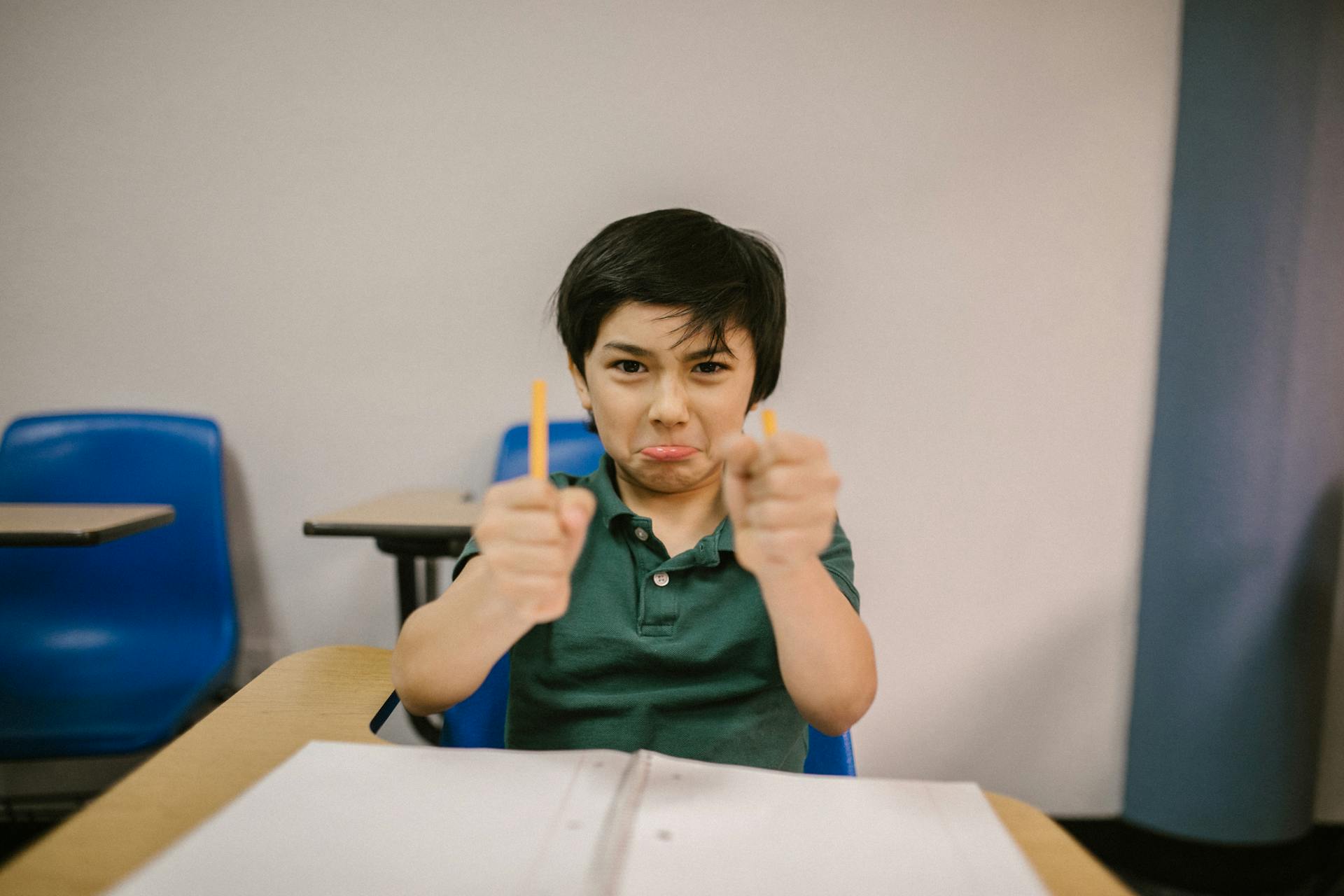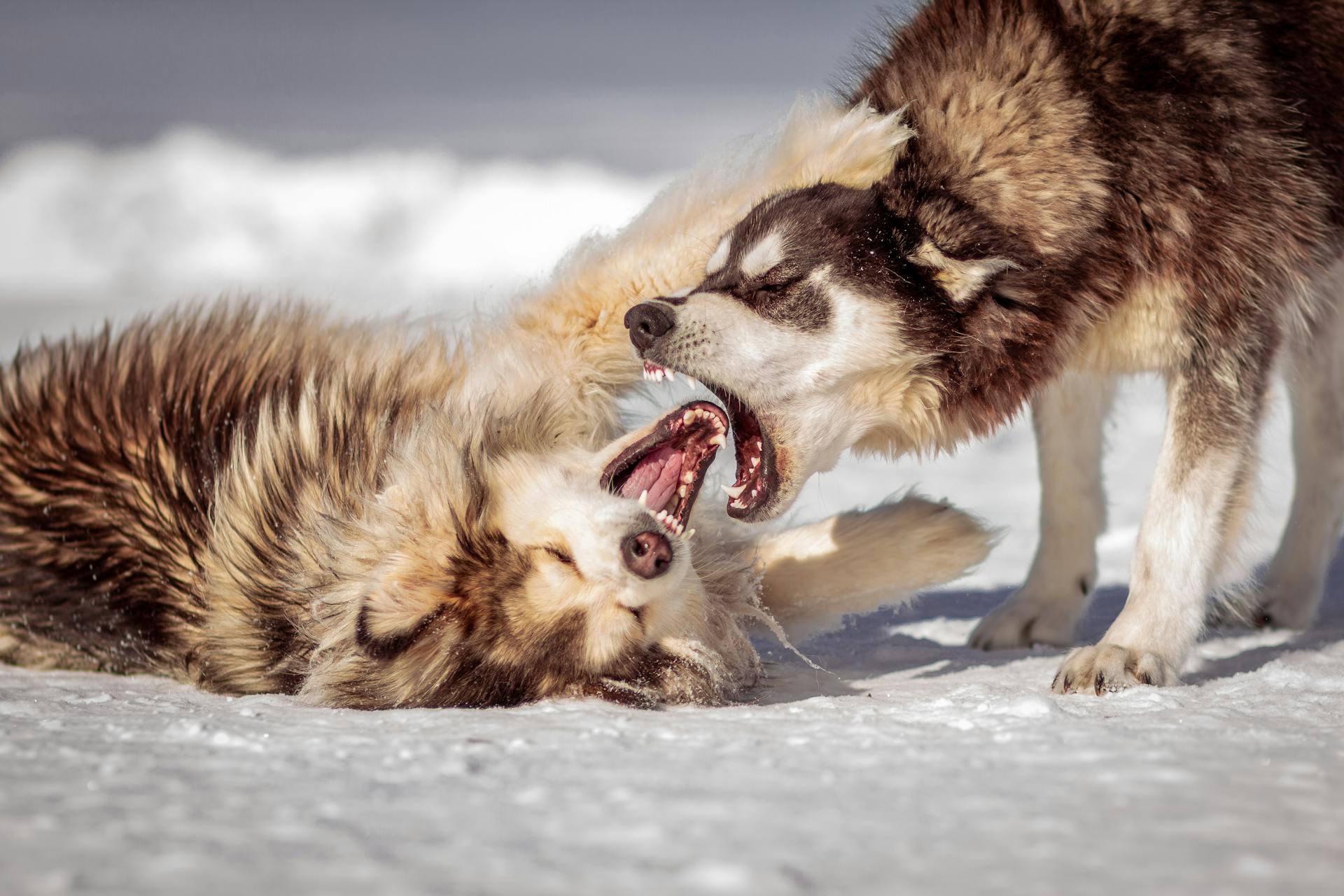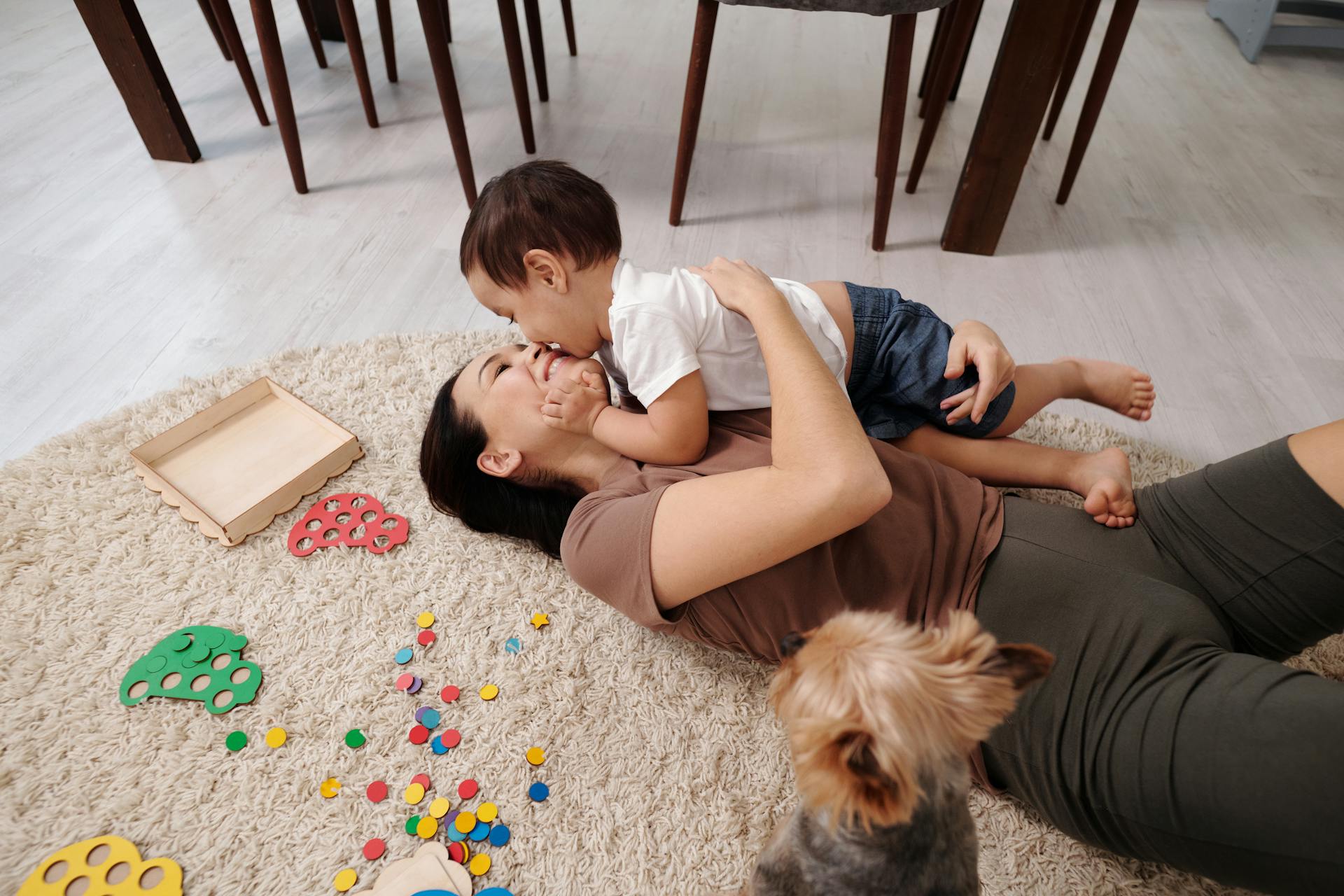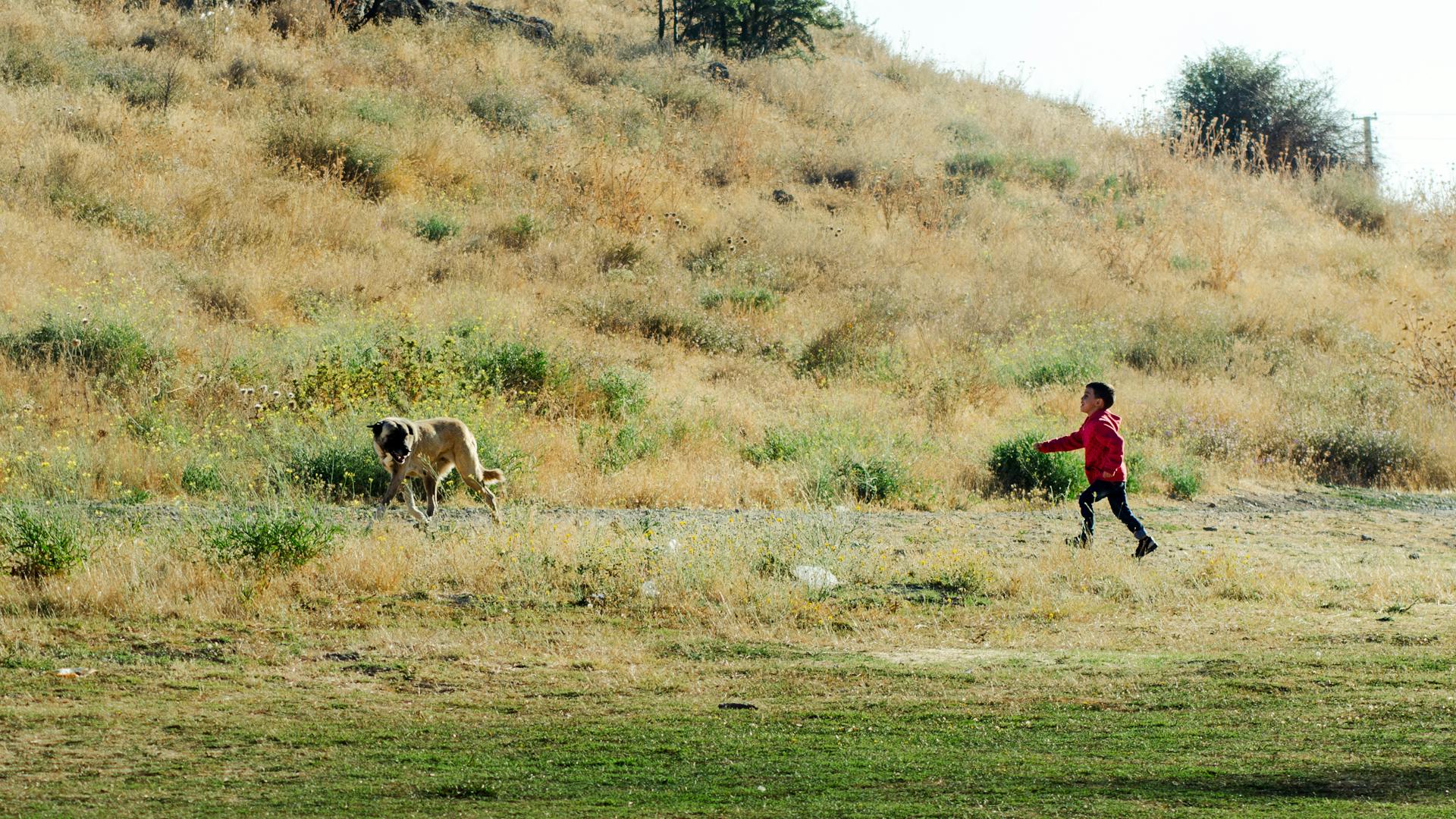
Dog food aggression towards a child can be a disturbing and concerning behavior. This behavior often stems from resource guarding, where a dog feels the need to protect its food from perceived threats, including children.
Dogs may view children as a threat to their food due to their curiosity and tendency to approach or touch the dog's food bowl. In fact, research has shown that dogs are more likely to exhibit resource guarding behavior when their food is near a child.
Children often unintentionally trigger this behavior by trying to pet or feed the dog while it's eating. This can lead to a dog becoming defensive and aggressive towards the child.
What Is Dog Food Aggression?
Dog food aggression is a behavior where dogs exhibit aggressive behavior when others approach while they're eating. This can include growling, snapping, or biting in defense of their food bowls or tasty treats.
Resource guarding is a common cause of food aggression in dogs. It's a natural behavior in canines, but in domestic dogs, it's a behavior that should be worked on eliminating as soon as it's observed.
Some dogs only display food aggression towards strangers, while others may behave aggressively to anyone. They may also inhale their food quickly to ensure no one can take it from them, which can lead to choking or increase the likelihood of worrying conditions like bloat.
Consistent, prolonged signs of aggression or protectiveness over food is a red flag that requires attention. Pet parents should work on managing this behavior through patient retraining, rather than disciplinary measures.
Dogs will often give a warning before attacking, so recognizing the behaviors your dog exhibits can help prevent injury to people and other animals.
Causes and Diagnosis
Causes of food aggression in dogs are often rooted in insecurities and past experiences. Dogs may display aggression due to being fearful or anxious, having been underfed or having their food taken from them consistently, or being stressed from a lack of control and routine.
A common cause of food aggression is competition for food with littermates. This can lead to a puppy developing the behavior of guarding their food, which can be hard to break.
Dogs may also display food aggression due to a desire to establish a hierarchy with unfamiliar animals or lack of confidence. Understanding these underlying causes is crucial in addressing the behavior.
Physical or emotional problems can also contribute to food aggression, and it's essential to rule out any systemic issues through a veterinary examination and possibly some tests.
What Are the Signs?
Knowing the signs of food aggression is crucial in determining if your dog has a problem. If your dog growls, lunges, or bites when you approach their food, they likely are struggling with food aggression.
Excessive vocalization is another sign to watch for, including barking or snarling when others are too close to their food.
Some signs of food aggression can be more subtle, such as eating or swallowing quickly, gulping, freezing while eating, stiffening or growing still, or staring at whoever is approaching.
If you notice any of these signs, it's essential to address the behavior early on to prevent it from escalating.
Here are some common signs of food aggression to look out for:
- Eating or swallowing quickly, gulping
- Freezing while eating
- Stiffening or growing still
- Staring at whoever is approaching
Causes

Food aggression in dogs is a complex issue with multiple underlying causes. Sometimes, it's a natural behavior that's been triggered by life experiences.
Dogs that display food aggression often have a physical or emotional problem, such as being fearful or anxious. They may have been underfed or had their food taken from them consistently, leading to resource guarding behavior.
Stress from a lack of control and routine can also contribute to food aggression. This can be particularly true for dogs that are adjusting to new environments or families.
A dog's desire to establish a hierarchy with unfamiliar animals can also lead to food aggression. This is especially common in multi-dog households where competition for food is high.
Lack of confidence is another underlying cause of food aggression. Dogs that feel insecure or uncertain may become more protective of their food.
Here are some common causes of food aggression in dogs:
- Are fearful or anxious
- Have been underfed or have had their food taken from them consistently
- Are stressed from a lack of control and routine
- Want to establish a hierarchy with unfamiliar animals
- Lack confidence
In some cases, food aggression can be a throwback to a dog's wild ancestors, who had to protect their food and resources in order to survive. However, this behavior is no longer necessary in domesticated dogs.
Competition for food with littermates is a major cause of food aggression in puppies. This can happen when multiple puppies are fed from a communal bowl, leading to aggressive behavior as they compete for food.
Related reading: Dog Aggression towards Puppies
Diagnosis

Diagnosis is a crucial step in understanding and addressing food aggression in dogs. Your veterinarian will need to know your dog's complete history, including dietary regimen, frequency, amounts, and types of food and treats.
A thorough history of your dog's littermates and interactions with other animals in the household is also important. This includes any interactions with humans in various activities.
Your vet will do a physical examination and may order tests if they suspect a systemic issue. They may also suspect food aggression or guarding behavior, which is a common root of the problem.
Documenting your dog's behaviors, especially at feeding time and in interactions with humans and animals, is vital. This will give your vet as much information as possible to diagnose and guide treatment.
Curious to learn more? Check out: Vet Approved Homemade Dog Food Recipes for Large Dogs
Managing the Behavior
Managing the behavior of a dog with food aggression towards children requires a thoughtful approach. Simply maintaining a safe distance while your dog eats may not be feasible if young children live in the household.
You could try managing the behavior, but this is only an option if your dog's guarding is mild and predictable. For example, if he only guards his food bowl, you could maintain a safe distance while he eats.
However, if your dog reacts with strong aggression around food, or you feel uncomfortable training him, seek help from a professional dog trainer or canine behaviorist who will use positive reinforcement methods to modify the behavior.
Manage the Behavior
Managing the behavior of a dog with food aggression requires understanding that it's not just about the food, but about the underlying insecurity motivating the behavior.
It's not always possible to change the behavior, so some people choose to manage it instead. This might be an option if your dog's guarding is mild and predictable.
You can manage the behavior by maintaining a safe distance while your dog is eating, but this isn't a feasible option if children or others who aren't able to follow strict management procedures live in the household.
If your dog reacts with strong aggression around food, it's best to seek help from a professional dog trainer or canine behaviorist who will use positive reinforcement methods to modify the behavior.
Leave It
Teaching your dog to "leave it" can be a game-changer when it comes to preventing resource guarding.
This behavior can be strengthened with lots of practice and positive reinforcement, allowing your dog to step away from a full food bowl when asked.
By teaching "leave it", you'll be able to ask your dog to leave things before he grabs them, preventing him from guarding.
It's a simple yet effective technique that can be learned with patience and consistency.
Here are some key takeaways to keep in mind:
- Practice "leave it" regularly to reinforce the behavior.
- Use positive reinforcement to encourage your dog to leave the item.
By mastering the "leave it" command, you'll be well on your way to managing resource guarding and creating a more peaceful dining experience for you and your dog.
Treatment and Recovery
Your pet's safety and well-being are top priority, and addressing food aggression is crucial to creating a loving environment for all.
A retraining program will be developed by a veterinary professional and an animal behaviorist to help your dog overcome aggressive behavior. This program may involve multi-stage or multi-step processes to teach your pet that they don't need to fear losing food or resources.
It's essential to understand that the older your dog is, the harder it may be to retrain them, and it may require a longer training period to achieve reduction or elimination of the behavior.
Treatment

Treatment is a crucial step in addressing food aggression in dogs. An appropriate treatment plan will be developed and initiated after a veterinary professional and animal behaviorist have evaluated the situation.
Your canine family member may require specialized home retraining to eliminate or reduce aggressive behavior. This can range from mild growling to protect special treats or food to reacting to any human who comes close when they're eating.
Not all food aggression needs to be treated, but if the aggressive behavior poses a risk of injury to humans or other household animals, a retraining program will be developed. These training programs are generally multi-stage or multi-step processes.
A multi-stage or multi-step training program will gradually teach your pet that they need not fear the loss of food or other resources they have traditionally protected.
Expand your knowledge: Treatment for Dog Aggression
Recovery
Recovery is a crucial step in helping your dog overcome food aggression. The older the animal is when training begins, the harder it may be to retrain them.

It's essential to remember that aggressive behavior in dogs should not be ignored. Your canine family member needs help, love, and patience to overcome these undesirable habits and behaviors.
The training period for recovery may be longer than expected, especially if your dog is older. But with consistent effort, you can achieve a safer and more loving environment for all parties involved.
If training is not successful, you can make adjustments at home at feeding time to isolate your pet. This means not leaving food down for your pet unless it's time for their meal.
Additional reading: Training Dog to Stay in Yard
Prevention and Veterinary Advice
Preventing dog food aggression towards children requires a multi-step approach.
First and foremost, it's essential to establish a consistent feeding routine for your dog. This can help reduce anxiety and stress around mealtime.
As mentioned earlier, some dogs may exhibit resource guarding due to their breed or past experiences. For example, breeds like the Chow Chow and the Akita are known to be more prone to resource guarding.
To prevent resource guarding, it's crucial to introduce your dog to food and children gradually and in a controlled environment. This can help your dog associate children with positive experiences.
Veterinary advice suggests that a combination of positive reinforcement training and desensitization techniques can be effective in addressing dog food aggression. In fact, studies have shown that dogs that receive positive reinforcement training are less likely to exhibit aggressive behavior.
A unique perspective: Can Dog Aggression Be Trained Out
Frequently Asked Questions
How do you fix a dog's aggression towards children?
Supervise interactions between children and dogs, and muzzle dogs that have shown aggression. Use a head-halter and leash to maintain control and prevent unruly behavior
Sources
- https://todaysveterinarypractice.com/behavior/preventing-dog-bites-in-children/
- https://community.whattoexpect.com/forums/june-2022-babies/topic/dog-showed-aggression-to-baby-advice-145938950.html
- https://www.dogster.com/dog-training/food-aggression-in-dogs
- https://wagwalking.com/condition/food-aggression
- https://animalwellnessmagazine.com/food-aggression-dogs/
Featured Images: pexels.com


